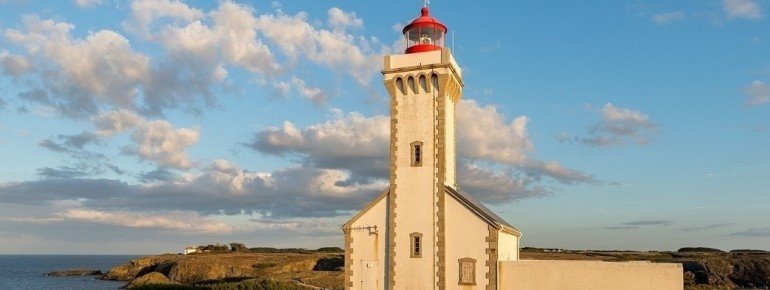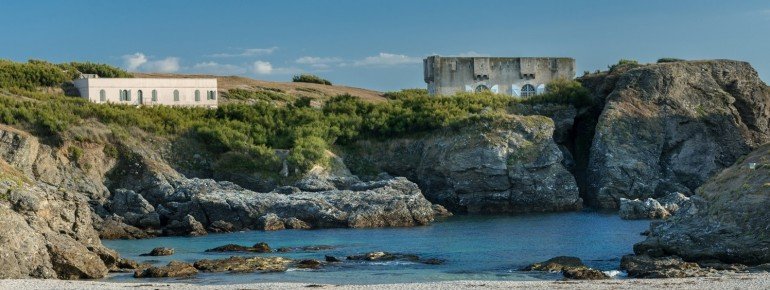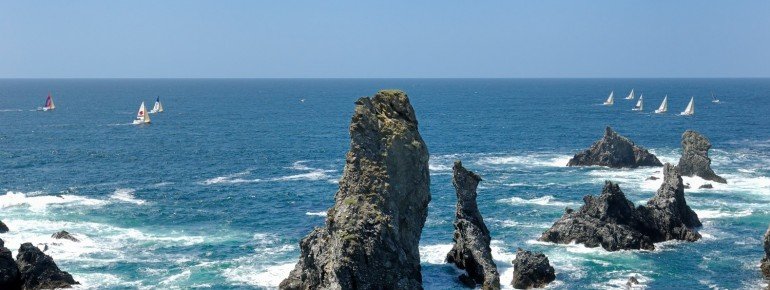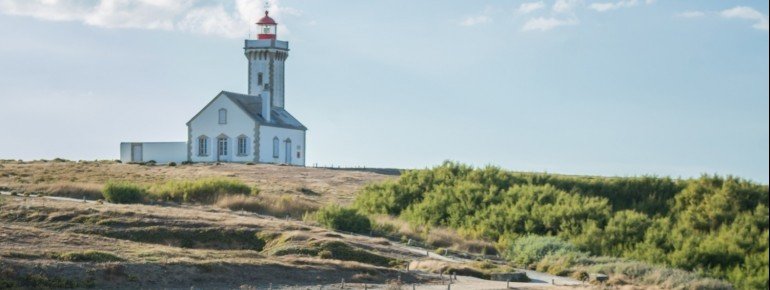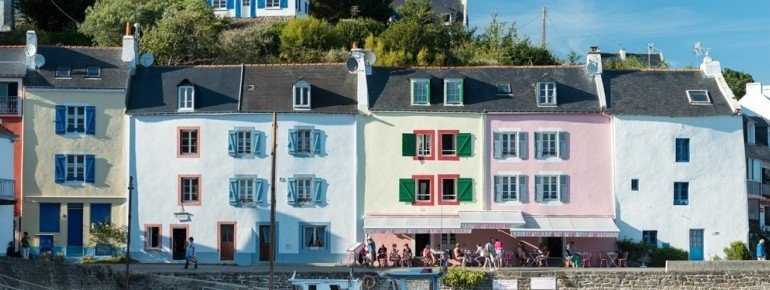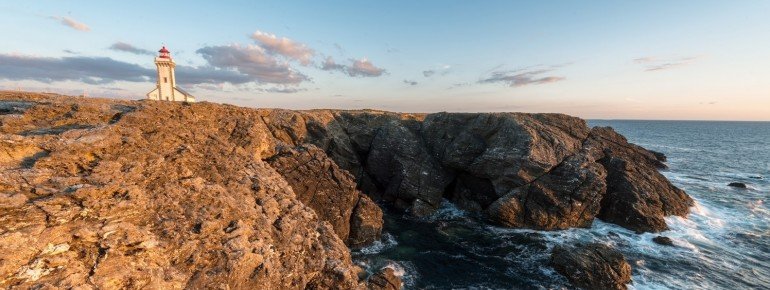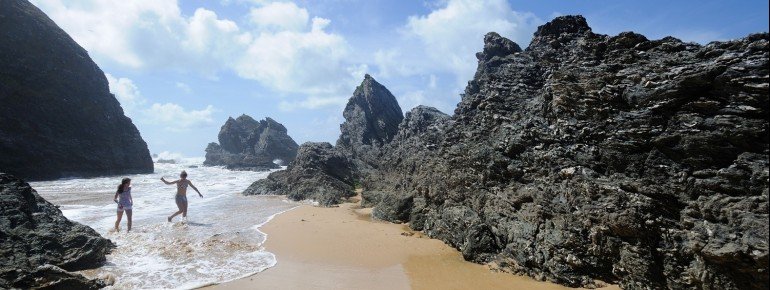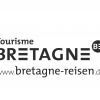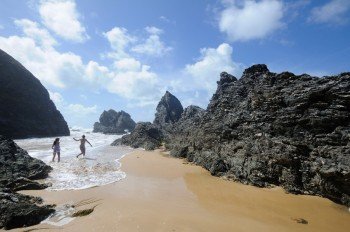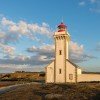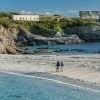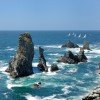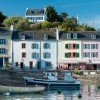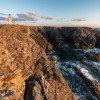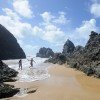Contents
Description
As promising as its name, Belle-Ile-en-mer is the largest and most beautiful island in Brittany. It is located 15 km from the headland of the Quiberon peninsula in the Atlantic Ocean. Wild, maritime and rural are probably the best words to describe the idyllic island in southern Brittany. The coast is characterised by fissured cliffs and lovely beaches, while the inside of the island impresses with wonderful valleys and rocky highlands. The painter Claude Monet has painted numerous artworks on the island and the actress Sarah Bernhard, who especially loved the wild cape „Pointe de Poulains“, was fascinated by the unique scenery.
The island at the edge of the Bay of Biskay, measuring twenty by nine kilometers, is known for its mild climate and many sunny hours a day. These circumstances allow you to really profit of the magnificent white beaches, spectacular cliff lines and colourful harbours. The around 5.000 inhabitants on the sparsely populated island live mainly of tourism, agriculture, fishery, as well as arts and handicrafts.
Between green fields and steep cliffs – a pearl of nature
The unique landscape of the Belle-Ile is a nature reserve. You can find rare ecosystems, such as shifting sand and grey dunes, coast and cornish heath, vegetation on the cliffs and even in the crevices. The amount of different plants and animals living in this landscape, makes it so rich and rare. Plantain, wild carrots and many protected types of orchids grow here. Add to these a number of endangered animals like nesting birds, green lizards and butterflies. Beside the wild nature on Belle-Ile you can also find magical, man-created gardens. The Jardin de la Boulaye and the Jardin Eden du voyageur impress with manifold flowerage.
Sand beaches on the Belle-Ile
Round about 60 gorgeous and wild sandy beaches invite you to take a swim on the Belle-Ile. Whether on large, fine sandy beaches or in small, protected bays – you can enjoy the sea and the sun everywhere. Especially recommendable for families is the sand beach Les Grands Sables. Like the beaches Donnant and Herlin, it is monitored by the water watch through July and August. Thanks to this, even the smallest can splash around safely in the shallow water. Another nice place to take a dip is the splendid beach of Bordardoué. The coast of the Belle-Ile, however, does not only invite for dips in the sea and sunbathing. You can also find a variety of watersports options, like for example sailing, surfing, diving, fishing, stand-up paddling, kajaking or taking a motorboat.
Exploring the island by foot or bike
An 83 km long walking trail leads you once around the gorgeous coast of the Belle-Ile. The trail is well sign-posted and you should plan four to five days for your hike. You'll be walking through high-grown fernleaf and small pine forests, while enjoying the beautiful panorama. Another good option is to explore the landscape by bike, which can be easily rented on the island. You need to be in quite good shape, though, as the ways are rather hilly.
Ventures and sights on the island
Beside the four towns Le Palais, Sazuon, Locmaria and Bangor, there are numerous tiny villages and of course the manifold landscape to explore. The best thing to do is to immediately rent a vehicle, with which you can discover even the smallest corners of Belle-Ile. The two seaports Le Palaisand Sauzon with their colourful houses, narrow alleyways, small shops and many cafés, invite to do a stroll. Artists and craftsmen offer visitors the possibility of looking over their shoulders in their ateliers and workshops while they are working. In Le Palais, visit the Vauban-Citadel from the 16th century. From the battlement you have an enchanting view over the harbour. Fans of Sarah Bernhard can take a look at her summer residence near the Pointe des Poulains, which is open to visitors since 2007. Also worth-seeing is the church of Locmaria. There are daily markets offering regional specialities in Le Palais and Locmaria. In other places, you can visit weekly markets. Among the most beautiful view points of the island are the red and white stripedlighthouse, the cliffs of the Grotte de l'Apothicairerie, the rock pinnacles of Port-Coton and Port-Goulphar. Beside the numerous water activities on Belle-Ile, you can also play golf, tennis, discover the high rope course, ride horses, go to the cinema or simply relax, for example during a sea water therapy.
Culinary feature: The Goose Barnacle (pouce-pied)
Foodies should taste the goose barnacle (pouce-pied). The strange crustacean can only be fished in a limited amount and can be found only in rare areas of the Atlantic coast. It is enjoyed cool, together with an appetizer. Of course you can enjoy other delicious, freshly caught fish and crustaceans on the island as well.
Useful information for your visit
High season on the island is in July and August. The Atlantic ocean has ideal temperatures around then. In the previous and in the following months, though, you can enjoy the idyll and quiet – but be prepared for cooler temperatures. If you are planning a longer stay, you have the choice among hotels, pensions and campsites. In the main season, it is advisable to book in advance.
Historical Information
The Beautiful Island has been inhabited already since the Paleolithic Age. During the Bronze Age numerous burial mounds were created, which you can still find in some heathers today. Fixed terrain spurs, however, are markers of the Iron Age. Finally, in the fifth century after Christ, the Bretons (from Great-Britain) found their way to the island. During the Middle Ages, Belle-Ile was often attacked by pirates, so the population was forced to build their first defense systems. Even later on, the island was the target of numerous attacks and was even used as a site for foreign marines. In 1658, finance minister Nicolas Fouquet - on the insistance of Ludwig XIV. - aquired the island, which by that time had become a Margraviate. A few years later the king himself became owner of the island. He had the island fortified and gave the administration of the budget into the hands of Brittany. After a short occupation of the island by the British (1761 – 1763), the land was divided among all its inhabitants. From the French Revolution until the end of the 19th century, the island gained wealth through agriculture, fishery and the ship building industry. These economic fields, however, came to a standstill in the course of the 20th century, and today the main income of the island is the tourism industry.
How to get there
Belle-Ile can be best reached by taking the ferry from Quiberon. To Quiberon, you get via the D768. You can park your car at the harbour at a fee-based car park. The crossing to Le Palais (all year round) or Sauzon (only in the holiday season), takes just about one hour. If you wish, you can take your car with you on the ferry, but be advised to book this in advance. The island even has a small airport. On-site, you can rent a mofa, a car or a bike to explore Belle-Ile.

